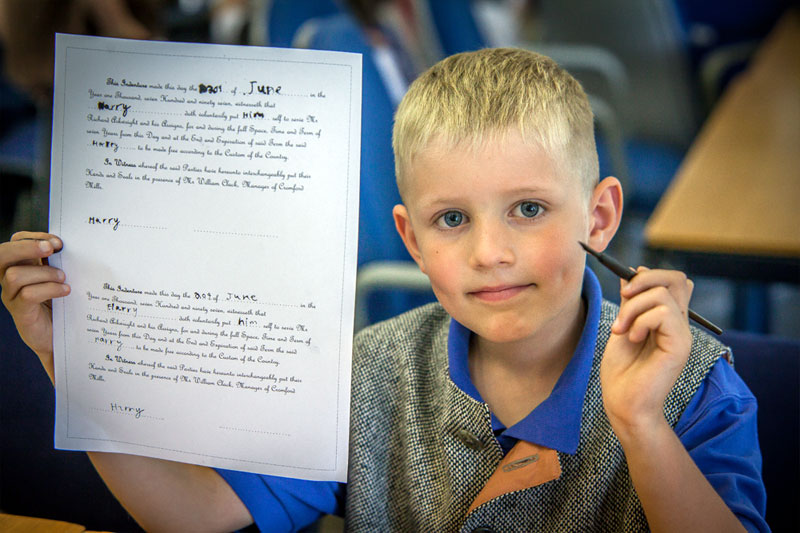'Toolkit' Case Study Example
Cromford Mills

Setting up a successful schools education programme
Case Study: Cromford Mills, Cromford, Derbyshire
Project completed 2015
Cromford Mills, the site of the world's first water-powered cotton spinning mill, created by Sir Richard Arkwright in 1771, runs a Sanford Award-winning education programme which focuses on Cromford's role in Britain's industrial heritage. We spoke to Education Officer Michael Ledger to find out what has made this programme such a success.
A conversation with Michael Ledger, Education Officer
The Arkwright Society
The programme and its audiences
In 2013 Michael and his team decided to create an education programme for primary schools, for whom the traditional guided tour of the site was not suited. The education programme now caters for three age groups: primary schools, secondary schools and further and higher education. While primary school groups engage in costume role play, secondary school groups have a guided tour of the mills, with occasional add-ons, and further and higher education groups are offered bespoke packages depending on the course subject, which can be anything from tourism to architecture. For details about the programme they run visit www.cromfordmills.org.uk/learning
Involving schools and education audiences in the planning
Despite having originally intended to have a schools’ forum to involve schools in the planning process, Michael and his team found that they were receiving sufficient feedback from the schools who came to Cromford and took part in the nascent programme. In addition to the evaluation sheets that were filled in at the end of a visit, the team found that teachers normally volunteered constructive feedback which was useful in the shaping of the programme.
Support available during development
The making of the programme itself took about six months, as it was being started from scratch. However the process was greatly aided by the trust’s involvement in the Sandford Cascade Project, set up by the Heritage Education Trust, which matches sites that have won the Sandford Award for excellence in heritage education with sites that are just starting out; Michael found this ‘a brilliant way of learning from other people’. The Cromford team was also assigned a Sandford Award judge as a mentor who pointed them toward other sites for inspiration. It was from visiting one of these sites that Michael picked up the idea of engaging primary school children with role play, which has proved very successful.
Learning through trial and error
At first, schools were offered a ‘menu’ of activities to choose from, however Michael found that this was unnecessary as most groups tended to choose the same options; ‘teachers prefer to have a set offer because then they can buy it and they know exactly what they’re going to get.’ He also found that schools preferred not to try to fit in too many activities and sites in one day. Scaling the visit down to role play in the morning with activities and a tour in the afternoon was much more successful.
What works well at Cromford Mills
At Cromford, role play is absolutely key, which relies on highly skilled volunteers. In addition, groups are divided into more manageable numbers to try four different hands-on activities within one hour, in order to allow everyone to try their hand in a ‘quick-fire’ manner, which Michael thinks works for the types of activities offered at Cromford.

Delivering the programme
Each role play session is run by two volunteers and Michael, who is a full time member of staff. The team are all in costume as they found that it wasn’t necessary for a member of staff or volunteer to step back and manage the groups out of character, and it allowed them to bounce off one another nicely.
Marketing to schools
Aside from occasional leafleting campaigns and evening receptions for head teachers, Cromford relies mainly on word of mouth. At Cromford research has shown that 95% of school visits are made on the back of word-of-mouth recommendations or previous experience; ‘your programme may be slow to grow, but once you get a few people coming, it grows.’ The vast majority of the schools that visit Cromford are from the area and come to do local history studies; and although some come from further afield, the team at Cromford have found that it is not really worth trying to market to those schools for the return that you get.
Further information
Michael’s ‘Top Tips’ for other heritage organisations who want to develop their education programme:
1. ‘Find the essence of the site and stick to it’. This was the key piece of advice Michael received from Cromford’s Sandford mentor. You have to stay true to what the site is all about and the story that you’re trying to tell. Look for the ‘wow’ moments; the things that are really going to inspire children and engage them.
2. Don’t chase the curriculum as it often changes unexpectedly. If your site is worth the visit, schools will find a way to fit it in.
3. Stick to simple, high-value activities that are site-specific.
4. Don’t be tempted to try and teach everything at once.
5. Get involved with heritage learning projects if you have one in your area.
In the East Midlands this is:
The Sanford Cascade Project
The Sanford Awards
Heritage Education Trust (run nationally)
Contact for more information:
01629 823256
Useful links:
www.heritageeducationtrust.org.uk
Our conversation with Michael Ledger took place in 2017.
Written by Holly Lomax for Heritage Trust Network.
